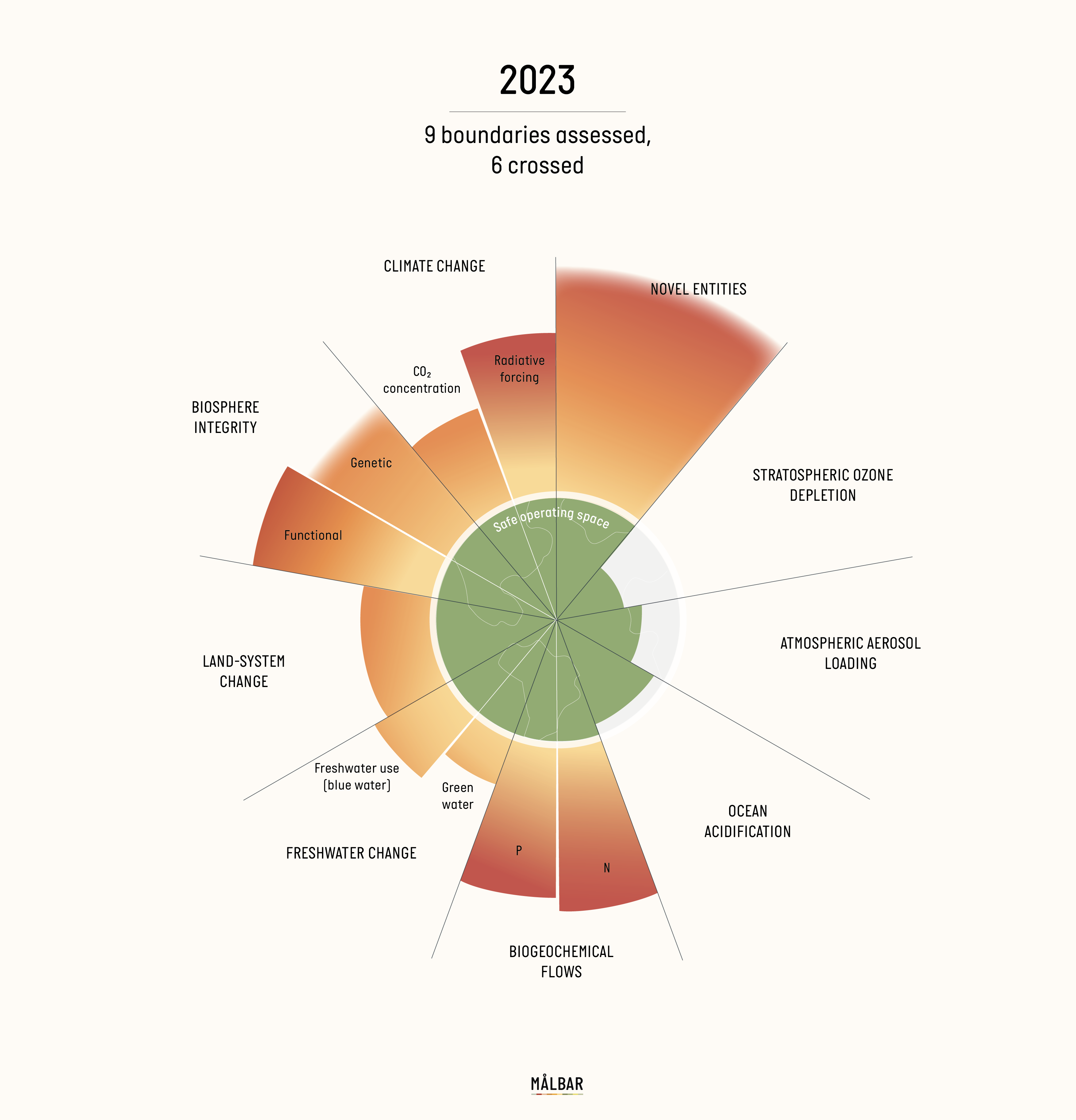
Most people and companies definitely talk as if we can. We use the terms sustainable and sustainability as relative terms when we communicate about more or less sustainable products, services, and companies.
Therefore, some scientists and organisations have introduced the term Absolute Sustainability. It is a concept created to stress the importance of calculating sustainability as an absolute thing. Either something is sustainable, or it is not.
When is a product or material absolute sustainable?
At Center for Absolute Sustainability at DTU, it is proposed that the framework of the Planetary Boundaries is used to determine if something is sustainable or not. We need to get away from only measuring sustainability in better or worse and instead look at whether a product or material is good enough. Whether it can exist within the planetary boundaries. Learn more here.
The era that we live in now, which has been going on for 11,700 years, is the only state of the Earth systems that we know for sure can support contemporary human societies.
However, there is increasing evidence that human activities are affecting the climate, weather, and environmental systems to a degree that threatens the resilience of the fundamental and critical processes that regulate our planet’s functioning. In other words: we might just be destroying our livelihood for good.
The fundamental operating systems of Earth
The Planetary Boundary framework is an approach from 2009, which is based on these critical processes that regulate the Earth systems.
It is built on scientific calculations of how human activity has the potential to destabilise the planetary ecosystems substantially and irreversibly. The framework identifies a so-called safe operating space for human activities on earth.
Don’t get us wrong, it is still very good and necessary to work towards “more sustainable products” – however, it would probably be more true to call it “less polluting products” or “less emitting products”.
The Framework describes 9 vital processes or systems that together maintain environmental balance on Earth. When human activity puts pressure on and transgresses the boundaries of these systems, the risk increases of severe or even irreversible changes in our climate, environment, and nature.

Fig. 1. Status of control variables for all nine planetary boundaries 2023.
Six of the nine boundaries are transgressed. In addition, ocean acidification is approaching its planetary boundary. The green zone is the safe operating space (below the boundary). Yellow to orange represent the zone of increasing risk. Red indicates the high-risk zone where interglacial (between ice ages) Earth system conditions are transgressed with high confidence. Values for control variables are normalised so that the planetary boundary lies at the same radius for all boundaries. The upper edge of the section for the novel entities is blurred because the upper end of the zone of increasing risk has not yet been quantitatively defined. The reason for the blurred edge at the genetic diversity component of the biosphere integrity boundary is that the current value is known only with great uncertainty (loss of genetic diversity). Both, however, are well outside of the safe operating space. Transgression of these boundaries reflects exceptional human disruption of Earth systems but is associated with large scientific uncertainties.
The 9 boundaries explained
Climate Change: The increase in greenhouse gas emissions from human activities is leading to a rise in global temperatures, resulting in adverse effects such as extreme weather events and sea level rise.
Biosphere Integrity: The loss of biodiversity and degradation of ecosystems are threatening the ability of the planet to support life and sustain critical ecological functions.
Stratospheric Ozone Depletion: The release of substances such as chlorofluorocarbons (CFCs) into the atmosphere has led to the depletion of the ozone layer, allowing harmful ultraviolet radiation to reach the Earth’s surface.
Ocean Acidification: The uptake of excess carbon dioxide by the oceans is causing a decrease in pH levels, leading to detrimental effects on marine life and ecosystems.
Biogeochemical Flows: Human activities, such as the excessive use of fertilisers and the release of pollutants, are disrupting essential nutrient cycles, affecting the health of ecosystems and biodiversity.
Land-System Change: The conversion of natural habitats for agriculture, urbanisation, and resource extraction is leading to the loss of biodiversity, soil degradation, and an increase in greenhouse gas emissions.
Freshwater Use: The unsustainable extraction and management of freshwater resources are leading to water scarcity, pollution, and ecosystem degradation.
Atmospheric Aerosol Loading: The release of particulate matter and pollutants into the atmosphere is influencing climate patterns, air quality, and human health.
Novel Entities: The introduction of new chemicals and substances into the environment, such as synthetic compounds and genetically modified organisms, can have unknown or harmful effects on ecosystems and human health.
The degree to which these boundaries are transgressed and pressured by human activities is continuously increasing. Målbar will ensure to follow the developments and update this post with the most recent calculations on an ongoing basis.
As so often before, climate change is considered one of the most urgent impact categories.
That is why Målbar’s PEF-based screening tool calculates on all climate effects of your products


